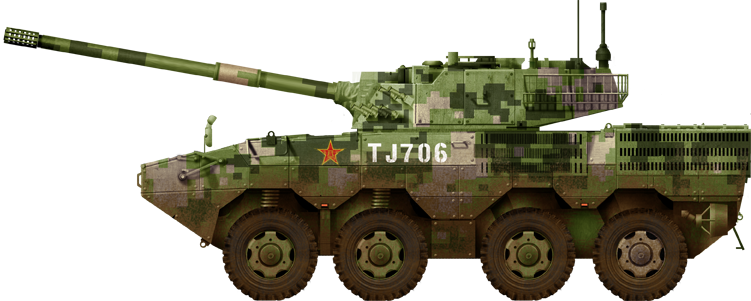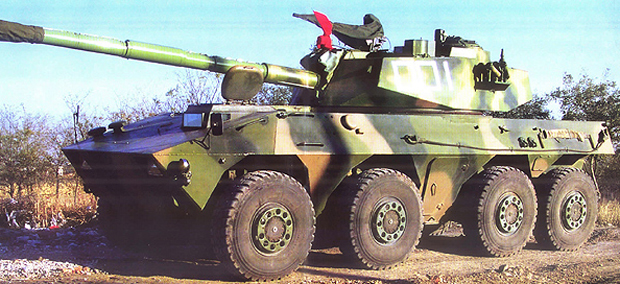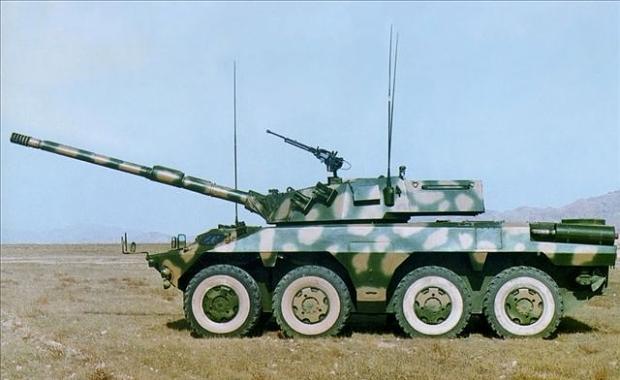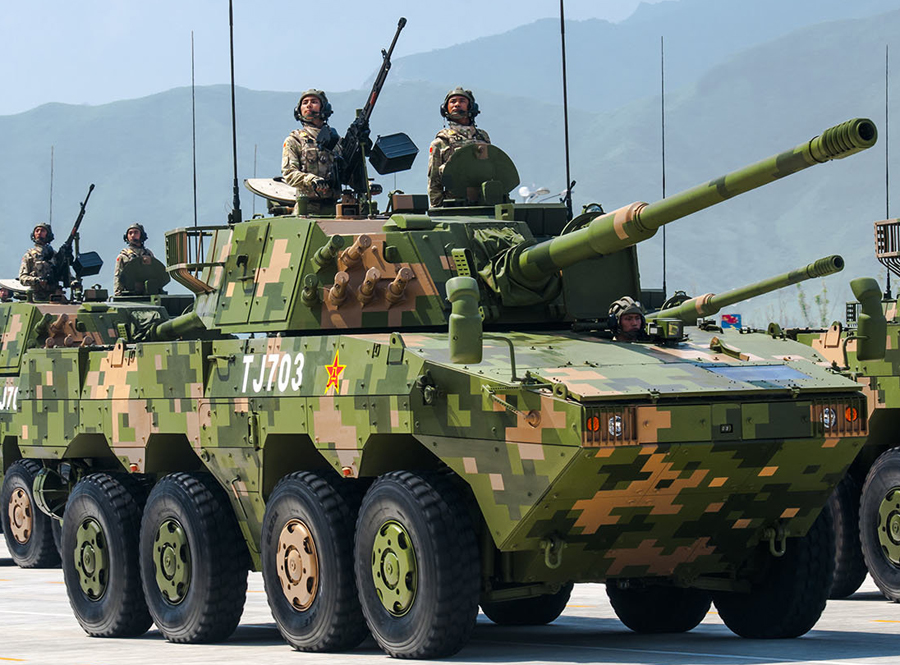
The ZTL-11 fire support vehicle was developed for the Chinese PLA, and sometimes as PTL-09 and ZTL-11 or Type 11. It entered service 2009 based on the ZBL-08, hence its designation. Used by Chinese marines, it is the only fuly amphibious support fire vehicle of its kind, prominently shown in amphibious exercizes and on the frontline for the invasion of Taiwan.
Design
Wheeled fire support vehicles being both chaper, faster, more flexible and easier to maintain than main battle tanks their rise had been from a fad to full adoption by all armies around the world. Although many experts would have them sidelines as uinsuitable for high intensity conventional combat, they became the centerpiece of recent, mostly asymetric conflicts. High speed and mobility on roads, now widespread in every countries, made them ideal to answer to a range of threats. Unlike MBTs they no not need need heavy transporters, have more tactical transport flexibility, and more modularity and compatibility sharing. One such aspect is the organic wheeled vehicle concept, invented by the Swiss in the cold war with the Piranha. A single platform, preferrably 8x8 for redundancy, space and lifting capability, could thus be declined into many variants all compatible and organic to a single motorized unit: APC, IFV, CEV, ATV, SPAAG, SPAAML, or FSV (Fire support vehicle). The latter can substitute tanks in some low lethality environments.The Chinese PLA staff decided to increased its own capability with such units, looking at US motorized units such as the Stryker Brigade combat teams. The PLA started in 2006 to work on a similar concept of rapid deployment units, each consisting of various armored vehicles, organically. They are tasked with different battlefield roles and complementing each others, making the whole unit autonomous in most situations. All variants uses the same platform, and in that case, the ZBL-09 armored personnel carrier.
The ZBL-09 entered service in 2009 and rapidly increased in numbers. By 2023, this is the most current Chinese AFV, with tanks units as support. The vehicle was declined into multiple variants: ZBL-08 Infantry Fighting Vehicle, ZSL-10 Armoured Personal Carrier, Type 08 Armored Reconnaissance Vehicle, Artillery Reconnaissance Vehicle, Electro-Optical Reconnaissance Vehicle, Assault Breach Vehicle, Command Vehicle, Communication Vehicle, Armored Ambulance, Electronic Warfare Vehicle, Satcom Vehicle, MICLIC, Mobile Bridge Buildern Armored Recovery Vehiclen Armored Cargo Vehicle, Engineering Vehicle. Or the Type 14 Hazardous Environment Reconnaissance Vehicle
As for dedicated support variants, the PLL-09 (Type 09) Modular Self-propelled Howitzer system, PGL-12 Anti-Air Gun-Missile System, ZTL-11 (and ZTL-09).
The later is the most powerful variant, based on the ZBL-09 APC chassis and tasked of infantry support based on its firepower, enabling to engage enemy armor if needed with dedicated ammunition as well as dealing with siftskin targets and fortfied objectives, buildings, field positions among others. In the same unit, it supplements the PTL-02 fire support vehicle using a 6x6 APC, but being more capable overall, faster, and with a more powerful gun. It enters the category of assault guns/wheeled tank destroyers, trading protection for speed and firepower. There is quite confusion in older sources stating the ZTL-09 was the same fire support vehicle. The PLA apparently changed its designation as ZTL-11 perhaps to signify it's real entry into service in 2011 and not in 2009. The ZTL-09 is perhaps a real thing, but is more likely a pre-serie version of the final production vehicle developed in 2009-2011.

ZTL-09 prototype

ZTL-09 pre-serie
Hull and general design
The ZTL-11 has a crew of four, including commander, gunner, loader and driver. Crew enter and leave the vehicle via side hatch or roof hatches. The same side hatch is used to load ammunition.Armament
The Turret is close to the one sported by the ZBD-2000 amphibious IFV, and receives a 105 mm gun, manually loaded, with an effective range of 2 000 m in direct fire. There is no precision about the kind of exact performances like the muzzle velocity or composition of the shells though. Western observers think it is likely furing the HEAT round, which in this caliber would be able to penetrates between 460 and 500 mm of rolled homogenous steel armor (RHA). But the ammunition storage certainly also incorporate APFSDS rounds to deal with serious armor, and of course HE rounds for infantry support. This caliber is also known to be comatible with the smallest Chinese gun-loaded anti-tank guided missile.The latter are laser-guided and a srivation of the Russian 9M117 Bastion type with a 5 000 m range and the ability to defeat 550-600 mm of RHA, behind Explosive Reactive Armor (ERA) protection, so in "tandem" mode, and with a hit probability claimed of about 90%. The Missile system also was geared to be capable of dealing with low-flying helicopters. Main battle tanks though should stay imperveous to this firepower, unless hit on a weak point. To that end, the Italian 120 mm armed B1 Centauro is certainly a better proposition.
The official information of the vehicle claims this gun iss assoviated to a modern and accurate fire control system. The practicality of the turret however in daily operation is marred by the lack of commander's panoramic sight, which precluded the use of a hunter-killer capability, now common on all MBTs and even modern wheeled tanks. However since the vehicle is not designed as a tank hunter but a fire support vehicle this should be less of a problem. In any case, tactical management is helped by digital battlefield system with modern displays now common on modern Chinese AFVs. The turret outside its main gun also comprises a coaxial 7.62 mm machine gun usable for extra guidance with tracers, and the usual roof-mounted W85 12.7 mm AA machine gun.
Protection
Pasive armour is light, and the welded steel armor hull is supposed proof against 25 mm armor-piercing rounds (typically the armament of a Bradley, BMP-2 and most IFVs today). This is for the glacis nose, but the sides and rear are downgraded to resist heavy MG rounds (cal. 0.5 in or 12.7 mm), also armor-piercing (AP) rounds, and needless to say shrapnel and small arms fire. Thos could be enhanced by add-on bolted ceramic armor modules panels. There is no certainty about it's protection against IED and mines, but the presence of four independent wheels certainly are a survivability asset. The vehicle is most certainly given a collective NBC protection systel with extra sealing and overpressure. There is certainly also a Halon type automatic fire suppression systems in the fighting and engine compartments. As for active protection, the ZTL-09 possesses in standard a turret-mounted battery of no less than twelve smoke dischargers, in two rows of 2+4 on either side, compensating for the lack of practical protection. There is no known active protection system like a laser warning receiver.Propulsion & Mobility
The Engine is relocated compared to the regular APC/IFV, to be mounted at the front and just behind the turret. It is very likely the same power unit as on the APC for parts commonality, so a Deutz BF6M1015C diesel engine rated for 440 hp produced under license, and connected to an automatic transmission. Due to the added weight of the turret, a better output should be in order, either with an improved version of the engine, or a new one entirely.Tactical mobility is helped on all-terrains by a central tyre inflation system, adjusted by the driver. But the greatest advantage is that the ZTL-11 is fully amphibious, which is remarkable given that type of heavily armed fire support vehicle is rarely proved to be so. This however imposed probably extra masured to seal the hull, reinforcing the idea it is NBC-proof. On water propulsion us assured by two waterjets driven by the main transmission and sub-coupling shafts at around 8 kph. The vehicle has a range of about 600 up to 800 km depending on the terrain, and could climb a 60% gradient or 0.55 m step, negociate a 30% side slope, gap a 1.80m trench, and ford any river or lake. It is not however sea-capable (and is never shown in navy camouflage nor known to be deployed with Chinese Marines), probably due to its heavy weight, limited propulsion and relatively modest trim vane. As for air mobility it is compatible with the heaviest lifters of the PLA, the Xi'an Y-20, which is also able to carry the Type 99A and Type 15 Tanks.
Production and Variants
Production starting date is not known with precision assumed to be from 2009 onwards. So far, production numbers are difficult if not impossible to pinpoint. Given the organic composition of the current fast deployment units sporting this family of vehicles, and given the global estimation of circa 6,000 vehicles of the Type 8, it's not unlikely to consider that at least 900 of the ZTL-09 variants had been delivered so far.Variants includes the following:
- Type 09 assault gun, possible preserie for the ZTL-11.
- ZTL-11A? Unidentified variant sporting a wedge-shaped turret and modified hull, not amphibious probably to armour upgrades.
- ST1: Export version with same rifled 105 mm gun, based on the VN1 armored personnel carrier chassis, with specific turret shared with the WMA301 fire support vehicle (2014)
- ZTL-15? Unidentified variant based on the VP-10 chassis. It has a bolted-on applique armor (STANAG 4569 level 3/4). But it is mostly sporting a new, larger turret this time with the very potent 125 mm L/60 gun developed by 127th Ordinance Institute (Central Northern University). Smoothbore, revealed in 2015 it is claimed of a muzzle velocity of about 2,000 metres per second, but some analysts also points out a new 130 mm field gun. The vehicle was still a prototype in 2016, and no knews had filtered since. It was likely developed from the ZTL-11A (prospective name).
ZTL-11 specifications | |
| Dimensions | 8/9m (gun forward) x 3 x 3.2 m |
| Total weight, battle ready | 20 t |
| Crew | 4 (driver, cdr, gunner, loader) |
| Propulsion | Deutz BF6M1015C diesel 440 hp |
| Suspension | Coil springs, Torsion bars. |
| Speed (road/water) | 100 km/h/8 km/h |
| Range | 600-800 km |
| Armament | 105 mm Rifled gun 30rds, 1 coax. 7.62, 12.7mm AA |
| Armor | See notes, Proof 12.7 - 25 mm AP |
| Total production | Circa 900 |
Gallery

PLA ZTL-11 in digital camouflage as shown in a 2015 parade.
Gallery

From military-today.com via pinterest


Norinco ZTL-11A (possible name) development Assault Gun FSV/AFV.

ZTL-11 in exercizes in Djibouti

ZTM-11 105mm support version

ZBD 11 105mm version. Credits: CCTV footage, military parade of September 3, 2015
Links/Src
links
deagel.com
militaryfactory.com/
globalsecurity.org
armyrecognition.com/
defence-blog.com
militarytoday.com
wikipedia.org
below-the-turret-ring.
Model kit review
Video

Modern Tanks
Modern MBTs posters

Denel Bagder (2018)

Type 16 MCV (2016)

Gepard 1A2 last rounds 2011

SANDF

Russian AFVs

Main Battle Tanks
